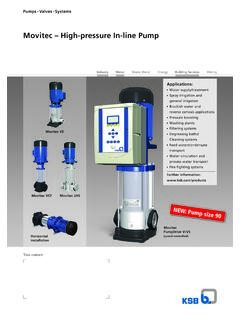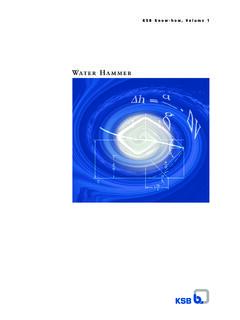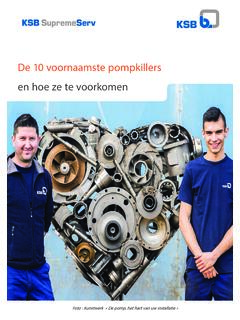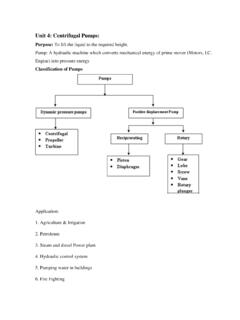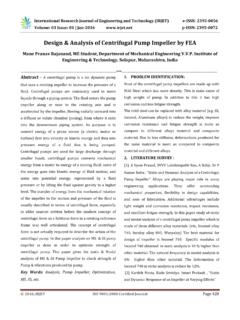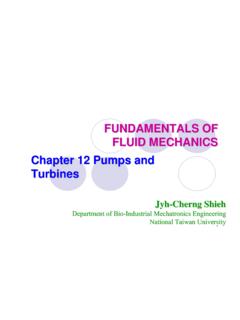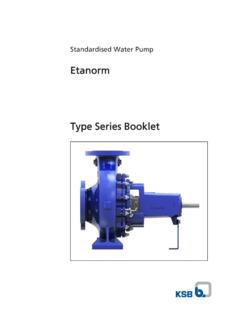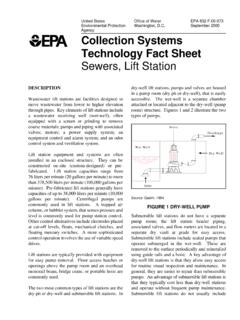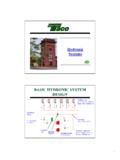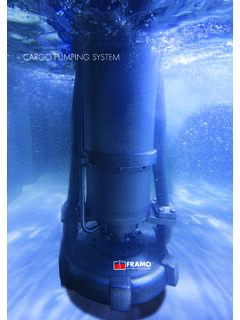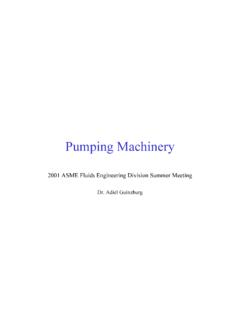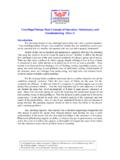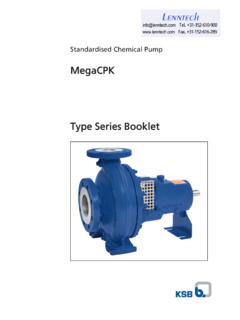Transcription of Selecting Centrifugal Pumps - KSB
1 Technical informationSelecting Centrifugal Pumps Copyright byKSB AktiengesellschaftPublished by:KSB Aktiengesellschaft,Communications (V5),67225 Frankenthal / GermanyAll rights reserved. No part of this publication may be used, reproduced, stored in or intro duced in any kind of retrieval system or transmitted, in any form or by any means (electro nic, mechanical, photocopying, recording or otherwise) without the prior written permission of the completely revised and ex panded edition 005 Layout, drawings and composition: KSB Aktiengesellschaft, Media Production V5 ISBN 00 0 784 4 4 Contents1 Nomenclature ..62 Pump Types ..8 93 Selection for Pumping Water .. Pump Data .. 0 .. Pump Flow Rate .. 0 .. Developed Head and Developed Pressure of the Pump.
2 0 .. Efficiency and Input Power .. 0 ..4 Speed of Rotation ..5 Specific Speed and Impeller Type ..6 Pump Characteristic Curves .. System Data .. 6 .. System Head .. 6 .. Bernoulli s Equation .. 6 .. Pressure Loss Due to Flow Resistances .. 8 .. Head Loss in Straight Pipes .. 8 .. Head Loss in Valves and Fittings .. System Characteristic Curve .. Pump Selection .. 8 .. Hydraulic Aspects .. 8 .. Mechanical Aspects .. 9 .. Motor Selection .. 9 .. Determining Motor Power .. 9 .. Motors for Seal less Pumps .. Starting Characteristics .. Pump Performance and Control .. 4 .4. Operating Point .. 4 .4. Flow Control by Throttling .. 4 .4. Variable Speed Flow Contol .. 5 . Parallel Operation of Centrifugal Pumps .. 6 . Series Operation .. 8 . Turning Down Impellers.
3 8 . Under filing of Impeller Vanes .. 9 . Pre swirl Control of the Flow .. 9 . Flow Rate Control or Change by Blade Pitch Adjustment .. 9 .4. 0 Flow Control Using a Bypass .. Suction and Inlet Conditions ..4 .5. The NPSH Value of the System: NPSHa ..4 .5.. NPSHa for Suction Lift Operation ..4 .5.. NPSHa for Suction Head Operation ..44 .5. The NPSH Value of the Pump: NPSHr ..44 .5. Corrective Measures .. Effect of Entrained Solids ..474 Special Issues when Pumping Viscous Fluids .. The Shear Curve .. Newtonian Fluids ..504.. Influence on the Pump Characteristics ..504.. Influence on the System Characteristics .. Non-Newtonian Fluids ..544.. Influence on the Pump Characteristics ..544.. Influence on the System Characteristics ..55 Table of contents55 Special Issues when Pumping Gas-laden Fluids.
4 566 Special Issues When Pumping Solids-laden Fluids ..576. Settling Speed ..576. Influence on the Pump Characteristics ..586. Influence on the System Characteristics .. Operating Performance .. Stringy, Fibrous Solids ..597 The Periphery ..6 7. Pump Installation Arrangements ..6 7. Pump Intake Structures ..6 7.. Pump Sump ..6 7.. Suction Piping ..6 7.. Intake Structures for Tubular casing Pumps ..647..4 Priming Devices ..657. Arrangement of Measurement Points .. Shaft Couplings .. Pump Nozzle Loading .. National and International Standards and Codes ..698 Calculation Examples (for all equations numbered in bold typeface) ..7 9 Additional Literature ..7910 Technical Annex (Tables, Diagrams, Charts) ..80 Tab. : Centrifigal pump classification ..8 Tab.
5 : Reference speeds of rotation .. Tab. : Approximate average roughness height k for pipes .. 0 Tab. 4: Inside diameter d and wall thickness s in mm and weight of typical commercial steel pipes and their water content .. 0 Tab. 5: Loss coefficients for various types of valves and fittings .. Tab. 6: Loss coefficients in elbows and bends .. 4 Tab. 7: Loss coefficients for fittings .. 4/ 5 Tab. 8: Loss coefficients for adapters .. 5 Tab. 9: Types of enclosure for electric motors to EN 60 5 9 and DIN/VDE 05 0, Part 5 .. 0 Tab. 0: Permissible frequency of starts Z per hour for electric motors .. 0 Tab. : Starting methods for asynchronous motors .. Tab. : Vapour pressure, density and kinematic viscosity of water at saturation conditions as a function of the temperature.
6 4 Tab. : Influence of the altitude above mean sea level on the annual average atmospheric pressure and on the corresponding boiling ..4 Tab. 4: Minimum values for undisturbed straight lengths of piping at measurement points in multiples of the pipe diameter D ..67 ContentsTables6A m AreaA m Distance between measuring point and pump flangea m, mm Width of a rectangular elbowB m, mm Vertical distance from suction pipe to floorCv gpm Flow coefficient for valves, defined as the flow of water at 60 F in US gallons/minute at a pressure drop of lb/in across the valvecD Resistance coefficient of a sphere in water flowcT (%) Solids content in the flowD m (mm) Outside diameter; maximum diameterDN (mm) Nominal diameterd m (mm) Inside diameter; minimum diameterds m (mm) Grain size of solidsd50 m (mm) Mean grain size of solidsF N Forcef Throttling coefficient of an orificefH Conversion factor for head (KSB system)fQ Conversion factor for flow rate (KSB system)f Conversion factor for efficiency (KSB system)g m/s Gravitational constant = m/s H m Head.
7 Discharge headHgeo m Geodetic headHs m Suction liftHs geo m Vertical distance between water level and pump reference plane for suction lift operationHz geo m Vertical distance between pump reference plane and water level for positive inlet pressure operationHL m Head lossH0 m Shut off head (at Q = 0)I A Electric current (amperage)K Dimensionless specific speed, type numberk mm, m Mean absolute roughnessk Conversion factors kQ, kH, k (HI method)kv m /h Metric flow factor for valves, defined as the flow of water at 0 C in cubic metres per hour at a pressure drop of barL m Length of pipeLs m Straight length of air filled pipeM Nm MomentNPSHr m NPSH required by the pumpNPSHa m NPSH availableNs Specific speed in US unitsn min (rpm) Speed of rotation s (rev/s)nq min Specific speed in metric units P kW (W) Power; input power 11 NomenclatureNomenclature7pe Pressure in suction or inlet tankPN (bar) Nominal pressure p bar (Pa) Pressure rise in the pump; pressure differential (Pa N/m )p bar (Pa) Pressure (Pa N/m = 0 5 bar)pb mbar (Pa) Atmospheric pressure (barometric)pL bar (Pa) Pressure losspv bar (Pa) Vapour pressure of fluid pumpedQ m /s, m /h Flow rate / capacity (also in litre/s)qair % Air or gas content in the fluid pumpedQoff m /h Flow rate at switch off pressureQon m /h Flow rate at start up pressureR m (mm) RadiusRe Reynolds numberS m Submergence (fluid level above pump).
8 Immersion depths mm Wall thicknesss m Difference of height between centre of pump im peller inlet and centre of pump suction nozzleT Nm Torquet C TemperatureU m Length of undisturbed flowU m Wetted perimeter of a flow sectionVB m Suction tank volumeVN m Useful volume of pump sumpv m/s Flow velocityw m/s Settling velocity of solidsy mm Travel of gate valve; distance to wallZ /h Switching cycle (frequency of starts)z Number of stageszs,d m Height difference between pump discharge and suction nozzles Angle of change in flow direction; opening angle Angle of inclination Loss coefficient (%) Efficiency Pa s Dynamic viscosity Pipe friction factor m /s Kinematic viscosity kg/m Density N/m Shear stress f N/m Shear stress at yield point Temperature factor; opening angle of a butter fly valve; cos : power factor of asynchronous motors Head coefficient (dimensionless head generated by impeller)1 Indices, Subscriptsa At outlet cross section of the system; branching offBl Referring to orifice bored On discharge side; at dis charge nozzle; flowing throughdyn Denoting dynamic com ponentE At the narrowest cross section of valves (Table 5)E At suction pipe or bell mouth inlet e At inlet cross section of system, e.
9 G. in suction or inlet tankf Referring to carrier fluidH Horizontalin Referring to inlet flowK Referring to curvatureL Referring to lossesm Mean valuemax Maximum valuemin Minimum valueN Nominal valueopt Optimum value; at best efficiency point (BEP)P Referring to pumpp Referring to pressurer Reduced, for cutdown im peller or impeller vaness On suction side; at suc tion nozzles Referring to solidsstat Static componentsys Referring to system / installationt Referring to impeller prior to trimmingV Verticalw Referring to waterz Referring to viscous fluid0 Basic position, referred to individual sphere , , Consecutive numbers; itemsI, II Number of Pumps oper atedNomenclature8 Table 1: Centrifugal pump classification Number of stages Single stage MultistageShaft position Horizontal Vertical Horiz.
10 Design Radial Axial Radial Axial Stage casingImpeller entries Motor type, Fig..Dry (standardized) motor a b c d e f g h Magnetic drive iSubmerged dry rotor motor (See .. ) j k l m Wet rotor motor (See .. ) n o p 2 Pump TypesTypical selection criteria for Centrifugal Pumps are their design data (flow rate or capac ity Q, discharge head H, speed of rotation n and NPSH), the properties of the fluid pumped, the application, the place of installation and the applicable regulations, specifications, laws and codes. KSB offers a broad range of pump types to meet the most varied design features for classifi cation are: the number of stages (single stage / multistage),2 the position of the shaft (hori zontal / vertical), the pump casing (radial, e.)


